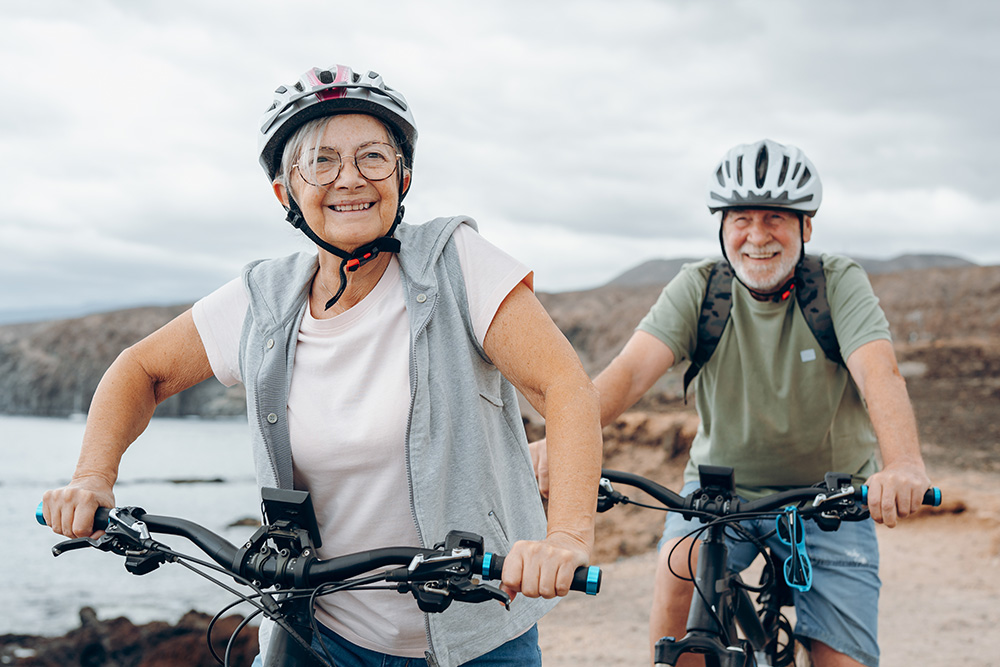Living with knee osteoarthritis can be challenging and painful, but many find relief through exercise. Cycling is one of the most effective forms of exercise for managing knee osteoarthritis.
This low-impact workout not only helps alleviate pain and preserve joint health but also offers several cardiovascular benefits.

By incorporating cycling into your routine, you can maintain or even improve your range of motion, strengthen muscles that support your knee, and enhance your overall quality of life.
Keep reading to discover the key benefits of cycling with knee arthritis, whether indoor or outdoor cycling is right for you, and how to choose the right equipment and pace for your recovery.
Cycling with arthritic knees helps loosen up your joints without putting too much pressure on them—it’s like adding lubricant to a squeaky wheel. Additionally, this study found that people with osteoarthritis who biked enjoyed less knee pain and reduced evidence of joint damage.
Here are some key benefits of cycling with arthritic knees:
Biking is a terrific exercise option for those with osteoarthritis knee pain. But is a stationary bike good for knees, or is an outdoor bike better?
When addressing knee osteoarthritis with cycling, you may wonder biking outdoors or using a stationary bike is better. Luckily, both have proven benefits.
Using a stationary bike can be beneficial for those with knee arthritis due to:
If you’re experiencing knee pain or are concerned about stability, a stationary bike might be the right choice. However, if you’re looking for a more engaging experience, cycling outdoors offers scenic changes that can encourage longer activity and adaptation to varying terrains.
Whether you cycle indoors or outdoors, choosing the right exercise bike is essential. Consider these types:
Indoor Bikes
Upright bike
These stationary bikes resemble traditional outdoor bicycles (upright riding position). They have adjustable resistance levels and are generally compact, making them suitable for small spaces. Upright bikes provide a good cardiovascular workout while maintaining a natural posture that can be comfortable for many users
Outdoor Bikes
Note: If you ride outdoors, take your bike to a professional for proper seating and handlebar height adjustments. When you have knee arthritis, cycling with your seat in a more elevated position can improve comfort, and raising the height of handlebars can alleviate neck or back pain.
Choosing the right bike type depends on your specific needs, preferences, and the severity of your arthritis knee pain. Consider factors like comfort, stability, speed, and the ability to adjust settings to find the bike that best supports your fitness goals.
When addressing knee arthritis through cycling, the pace and intensity of your rides significantly impact joint health. Research suggests that low-intensity cycling is as effective as high-intensity cycling for improving joint function and reducing pain in knee osteoarthritis.
If you are new to arthritis and cycling, start slowly with short, flat rides. Your first session should last between five and ten minutes.
As you become more comfortable, gradually increase both the duration and intensity of your rides. Aim for moderate intensity and work towards achieving up to 150 minutes of biking per week. Always listen to your body and stop exercising if you experience any discomfort or pain.
If you experience new or worsening joint pain during or after cycling, discontinue your workouts immediately and consult with your doctor.
If you have knee arthritis, cycling is a valuable tool for loosening stiff joints and enhancing range of motion and mobility in individuals with knee arthritis.
However, it’s important to give your body time to recover after a workout. Engage in gentle stretching exercises that complement your cycling workouts.
If you find that exercise and lifestyle measures alone are not providing sufficient knee pain relief, request a consultation with the experts at the Georgia Knee Institute to explore whether genicular artery embolization is right for you.

Atlanta
3225 Cumberland Blvd. Southeast, Suite 520
Atlanta, GA 30339
Stockbridge
1035 Southcrest Dr., Suite 220 + 250
Stockbridge, GA 30281
Tucker
1975 Lakeside Pkwy., Suite 300
Tucker, GA 30084
Scheduling
Please contact our dedicated specialists to schedule a consultation today.
2025 Georgia Knee Institute. All rights reserved. Website Design by Healthcare Success